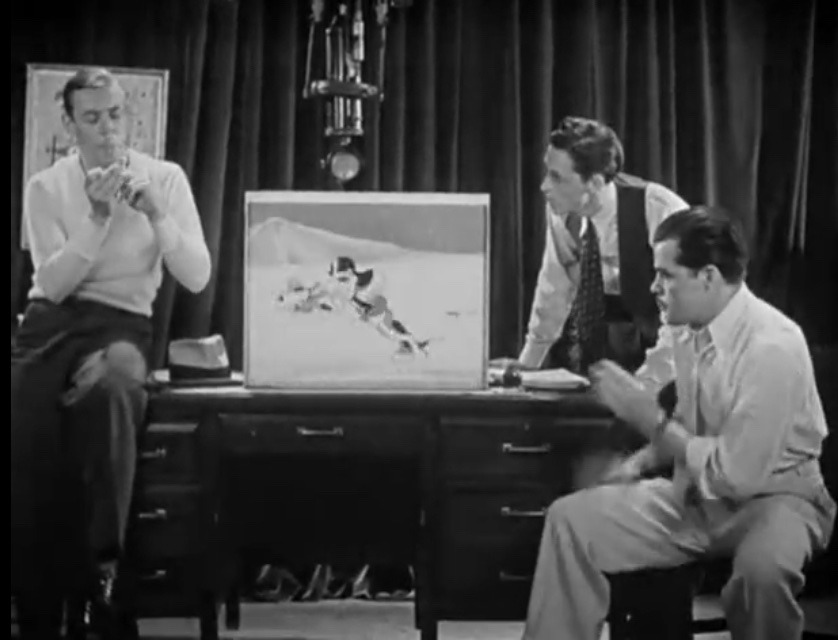Release date: November 12th, 1932
Series: Merrie Melodies
Director: Rudolf Ising
Starring: Johnny Murray (Mannequin), The King's Men (Chorus), The Rhythmettes (Chorus), Rudy Ising (Ted Lewis)
More inanimate objects coming to life! This one’s very fun and cute. A mannequin dumped in a junkyard comes to life and makes the best of his situation by playing music for all to hear.
The cartoon begins with a man on a horse drawn cart, lugging a great big pile of junk. Like every responsible driver, he’s asleep at the reins. All of the hats on him slide down as he nods off, but catches himself and the hats stack up on his head perfectly, the gag repeating.
Reaching a cliff, the contents of the cart are dumped below into the city junkyard. A mannequin falls out, and a hit of falling debris to his head wakes him up. A cuckoo clock cuckoos at him effeminately as he stares at it dubiously.
Our mannequin saunters off and spots a broken piano, and figures he’ll pass the time by tickling the ivory. Unfortunately, just the keys and hammers are left, no strings.
Nothing some good old garbage can’t fix! He fashions himself a piano and sings “ A Great Big Bunch of You”, which proves itself to be quite the catchy tune! I love the mannequin, he has a lot of charisma to him. Might be the design, from the bowler hat to the Charlie Chaplin mustache to gaudy gingham pants. Maybe he is supposed to be Charlie Chaplin? Though he has a striking resemblance to bob McKimson, too...
As he sings, there are, of course, visual gags to accompany the scene. One includes a pair of shoes dancing, sticking out the tongues inside like actual tongues.
The mannequin gets up from his stool and, turning his feet sideways, uses them as wheels to glide over to a hat stand. Great gag of the feet turned wheels! I know it’s just your standard “come to life” cartoon, but that’s certainly creative. Anthropomorphized mannequins aren’t something you see too often. He puts on a hat and sings, doing an impression of Maurice Chevalier, a popular French entertainer. He was a big hit in 1932 with his romance musical “Love Me Tonight”, which came out 2 months before this cartoon was released.
He receives raucous applause from the inanimate objects—including the victor records dog, barking at a cash register.
Show’s not over yet, folks! The mannequin plays some corn through his horn, while inanimate objects dance to the music, including an elderly grandfather clock and a group of toy soldiers (from Red-Headed Baby), shooting bottles in time with the music. They shoot a painting of some men in a boat (a reference to Washington crossing the Delaware? Or Watson and the lack of a shark?) and the boat sinks, the American flag still standing above the waters. Out come a group of soldiers playing a fife and drum march.
Our charismatic dummy uses a bath mat to glide over to an orchestra (which sounds fantastic!) A clock swings its pendulum, beating against two “drums”. Elsewhere, another mannequin strums the water coming out of a shower head like a harp, reused from Sinkin’ in the Bathtub. They wanted to show they could synchronize music and animation, and they were right!
The Andrews Sisters look a lot different than I remembered. They sing the titular song in beautiful harmony while a pair of hat stands dance in time to the music. This whole sequence is indescribably cheery and upbeat! It’s certainly one of their better efforts at this genre of cartoons.
Finally, the Chaplin-esque mannequin plays a vacuum cleaner like bagpipes, a car in disarray sputtering along. He dives back to his piano to sing some final notes, interrupted by more trash getting dumped on him. In the style of Ted Lewis, he asks “Is everybody happy?” as we iris out.
“Is everybody happy?” Yes! Such a fun, endearing, and upbeat cartoon! You Don’t Know What You’re Doin’! Still stands as my favorite Merrie Melody so far, but this is certainly a strong contender! The song is lovely and the music score is jazzy and fun. The visual gags are very appealing and pleasing to listen to synchronized with the sound effects, and the premise itself is very entertaining and endearing! You should definitely give this one a look, I was grinning like an idiot by the end!





















































